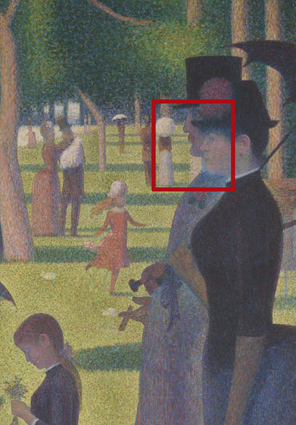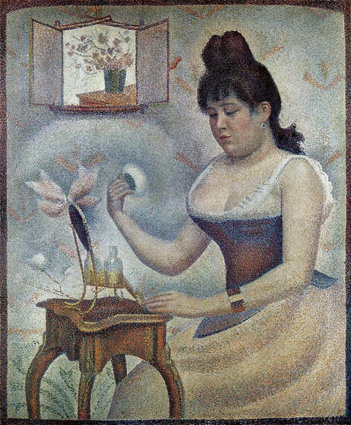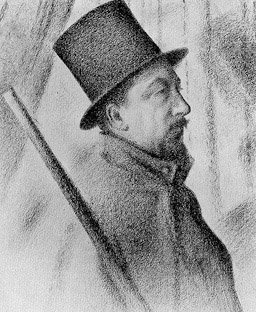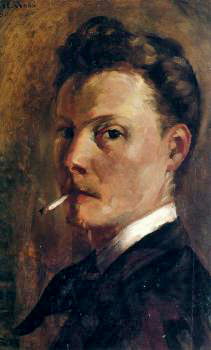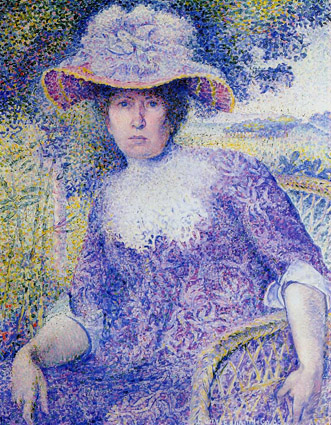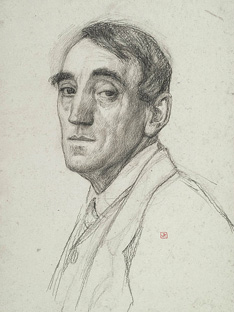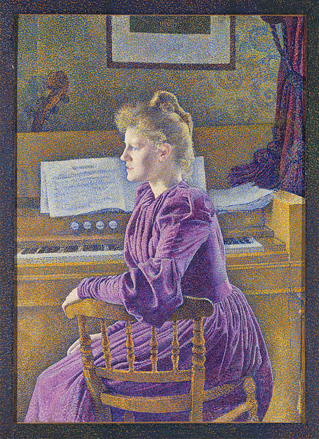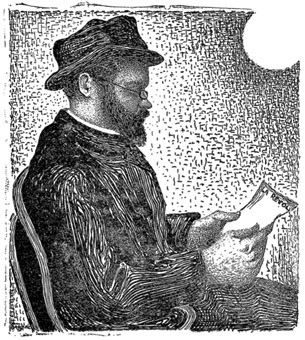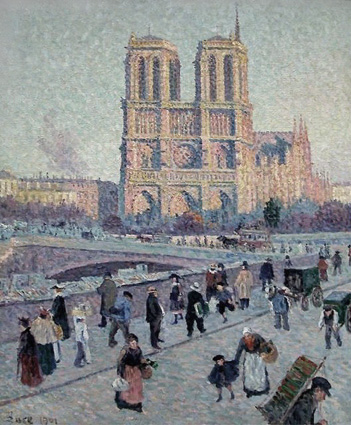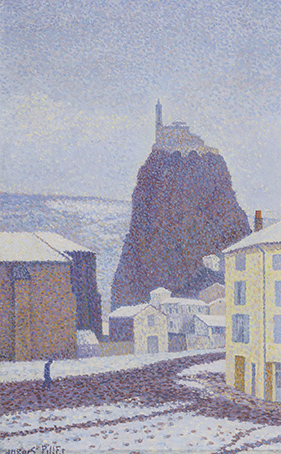
Home |
||
|---|---|---|
Before the exhibitions |
Eight Impressionism exhibitions |
After the exhibitions |
|
||
The pointillism
Pointillism as a reaction to Impressionism
At the eighth and last of the series of Impressionist exhibitions, which took place in 1886, a number of painters presented a new style of painting, Pointillism. Georges Seurat himself called this style of painting, which was probably mainly developed by him, Divisionism, while the common name Pointillism (French point = dot) comes from the second famous representative, Paul Signac.
Painting theory was based on new scientific findings on colour theory, perception and, above all, additive and subtractive colour mixing. While additive mixing describes the results of different primary colours through light, subtractive mixing is the result of a colour mixture created by light reflected from a surface. Both types are well known in today's technology: Additive is the basis of colour television and colour screens, while subtractive is the basis of all colour printed matter. In both cases, colour is created in today's technology by the interplay of coloured dots: on the screen by the colours red-green-blue, in printing by the colours cyan-magenta-yellow. This allows almost all colours of the spectrum to be produced, although the possibilities of subtractive mixing are much smaller than those of additive mixing.
Although pure colours were largely used in painting at the time, they were not limited to three primary colours alone. However, by using various very pure colours, the mixture of colours only emerges in the eye of the beholder.
Here you can see the pointillist working method up close: (Detail from the famous painting "La Grande Jatte" by Seurat)
Seurat - Un dimanche à la Grande-Jatte
(shown in the 8th exhibition of the Impressionists)
1884/86 - 207 x 308 cm - Oil on canvas
Art Institute of Chicago, USA >
Pointillism as a formal language was used from around 1880 to 1910. Alongside the aforementioned Seurat and Signac, representatives of this style of painting for a few years were Pissarro and then Henri Cross, Theo van Tysselberghe, Maximilien Luce, etc. Many painters, such as Vincent van Gogh, Henri Matisse and Paul Klee, explored this style of painting from time to time.
Georges-Pierre Seurat
* 2. 12. 1859 in Paris; † 29. 3. 1891 Paris
Seurat came to the École des Beaux-Arts via drawing courses with a sculptor. He learnt painting from a teacher who worked in the style of Ingres. He studied the old masters at the Louvre. A visit to the Impressionist exhibition in 1979 with paintings by Degas, Pissarro and Monet made him say goodbye to academic painting. As a result, he began to explore optical problems in painting. All his studies led to experiments in painting, initially with colour mixtures, but soon to what made him famous: painting with separate dots of colour. His first very large painting (a bathing place near Asnières) was rejected at the Salon. However, he was able to show it at the exhibition of the Societé des Artistes Indépendants, an association founded in 1884. It was there that he met Paul Signac, with whom he became close friends.
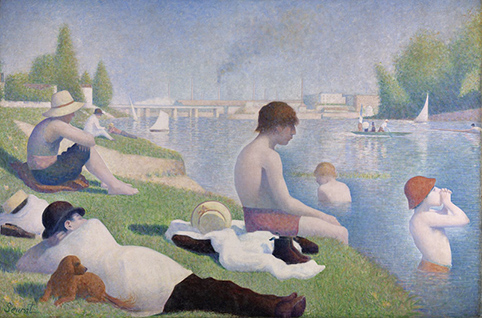
Une baignade à Asnières
1884 - 202 x 301 cm - Oil on canvas
National Gallery London, United Kingdom >
In 1886, Seurat took part in the last Impressionist exhibition organised by Pissarro. Among other things, he showed his famous painting "A Sunday Afternoon on the Island of La Grande Jatte" there
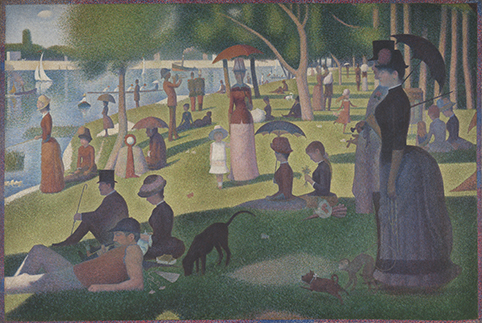
Un dimanche après-midi à la Grande Jatte
1884 - 207 x 308 cm - Oil on canvas
Art Institute of Chicago, USA >
In 1887, the Neo-Impressionist group was founded, of which he became a member. Pointillism was represented there by him as well as Paul Signac, Maximilien Luce, Theo van Rysselberghe and others. Seurat took part several times in exhibitions organised by the artists' group "Le Vingt" in Brussels, where he showed the painting "Le Cahut", among others. Seurat died of diphtheria in March 1891.
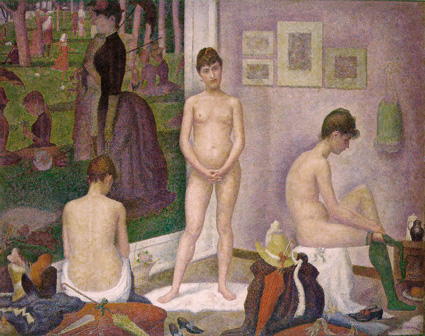
Les Poseuses
1884/86 - 200 x 250 cm - Oil on canvas
Foundation Barnes, Philadephia, USA >
Femme avec une houppette
1889/90 - 95 x 79 cm - Oil on canvas
Courtauld Institute of Art, London >
La Tour Eiffel
1889 - 25 x 15,7 cm - Oil on wood
Fine Art Museums of San Francisco >
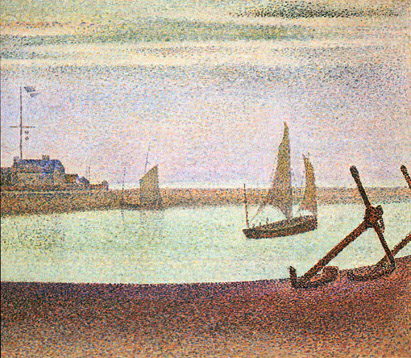
Le canal de Gravelines, le soir
1890 - 65 x 82 cm - Oil on canvas
The Museum of Modern Art, New York >
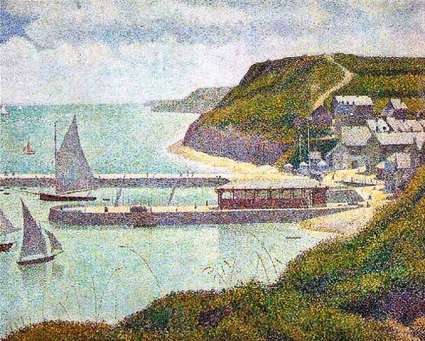
Port en Bessin, port extérieur
1888 - 66 x 82 cm - Oil on canvas
Musée d'Orsay, Paris, France >
Paul Signac
*11. 11. 1863 Paris- † 15. 8. 1935 Paris
Paul Signac (Drawing by Seurat)
A Monet exhibition in 1880 was the trigger for Signac to start working artistically from then on. While his first paintings were strongly influenced by Monet, with whom he had a long friendship, he also sought training in a studio. In 1884, he exhibited Impressionist paintings at the Salon des Indépendants. He usually spent the summer in Port-en-Bressin, where he met Seurat in 1884, an encounter that was decisive for his future work. He was very enthusiastic about the principles of pointillism and became a driving force behind this style.
In 1886, he exhibited several works together with Seurat at the eighth Impressionist exhibition. Most of his paintings are landscapes, mostly coastal scenes. His connection to the sea was also evident in the fact that he worked as a sailor. In the course of his life, he owned over 30 ships.
Signac painted fewer people and interiors, but there are some very beautiful and well-known pictures:
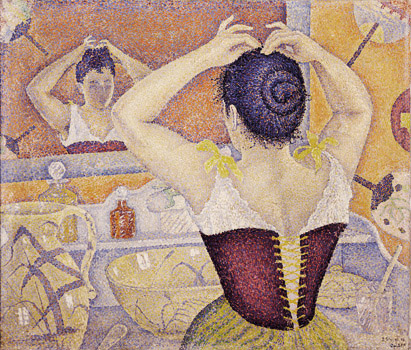
Femme se coiffant
1892 - 59 x 70 cm - Oil on canvas
Private collection
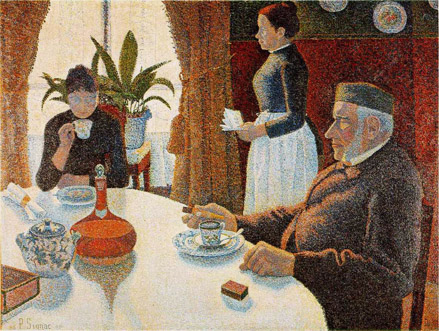
Le petit Déjeuner
1886/87 - 89 x 110 cm - Oil on canvas
Kröller-Müller Museum, Otterloh, Niederlande >

Portrait de Félix Fénéon
1890/91 - 74 x 92 cm - Oil on canvas
Museum of Modern Art, New York, USA >

La Terrasse, Saint-Tropez
1898 - 72 x 91 cm - Oil on canvas
Musée de l’Annonciade, Saint Tropez, France
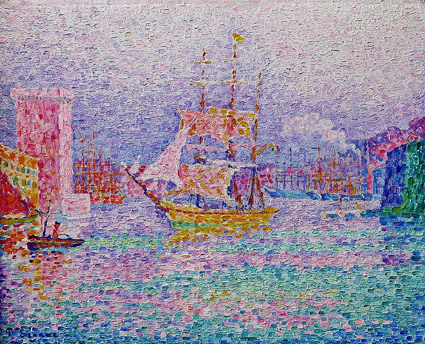
Le Port de Marseille
1906 - 46 x 55 cm - Oil on canvas
Hermitage Museum, St. Petersburg, Russia

Le Phare de Groix
1925 - 74 x 82 cm - Oil on canvas
The Metropolitan Museum of Art., New York, USA >
Camille Pissarro
* 10. 7. 1830 Charlotte Amalie, Danish West Indies † 12. 11. 1903 in Paris
Camille Pissarro about 1888
In 1885, Pissarro became acquainted with Seurat and Signac and their painting techniques. The style convinced him. He had previously created his paintings in this way to some extent because his brushstrokes had already become very short. Now he added pure, unmixed colours, which were no longer placed on top of each other but next to each other to create brighter colours.
In 1886, against considerable resistance, he managed to ensure that the Pointillists were allowed to take part in the eighth Impressionist exhibition. However, he had to accept that the painters whom Pissarro now called "Romantic Impressionists", Monet, Renoir, Sisley and Caillebotte, withdrew and did not take part in the exhibition. This certainly also led to the end and disintegration of the Impressionist group, who from then on had little contact with each other.
Even if there were appreciative voices, Pissarro was unable to find buyers for the new paintings. The art dealer Durand-Ruel considered the painting style to be a mistake anyway and broke off his relationship with Pissarro for some time. Pissarro also no longer wanted to have anything to do with the art dealer who had always supported the Impressionists (including financially).
However, it should also be noted that Pissarro himself was dissatisfied after a few years. He felt constricted by the rigid, but also very time-consuming style of painting. It was therefore no wonder that from around 1892 onwards he largely devoted himself to more impressionistic painting, which was perhaps more suited to him. His relationship with his patron Durand-Ruell also normalised again and in 1892 Pissarro's breakthrough and recognition as a painter came at his gallery. Pissarro's lifelong and extremely critical money worries finally came to an end in his 62nd year.
Here are some pointillist works from the years 1886 - 1890, which certainly correspond to the quality of Pissarro's painting as a whole.
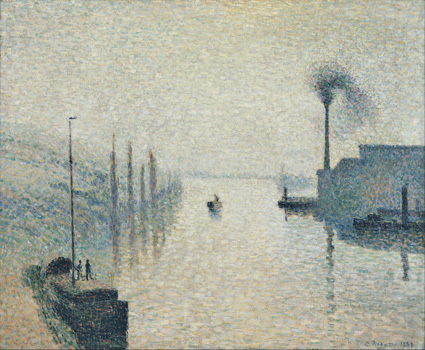
L'Île Lacroix, effet de brouillard, Rouen
1888 - 44 x 55 cm - Oil on canvas
Philadelphia Museum of Art, Philadelphia, USA
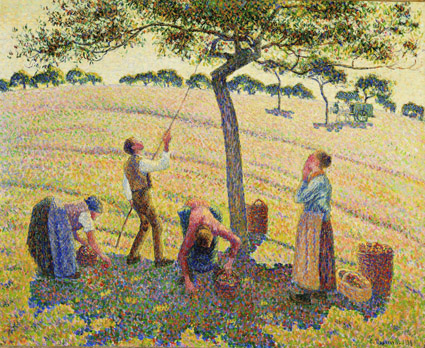
La récolte des pommes à Éragny
1888 - 58 x 72 cm - Oil on canvas
Dallas Museum of Art, Dallas, USA >
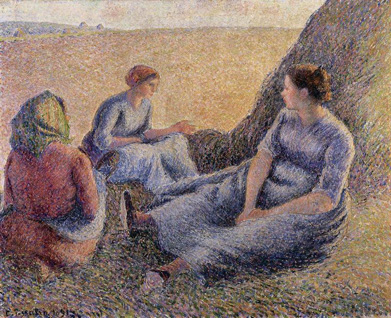
Faucheuses au repos
1891 - 65 x 81 cm - Oil on canvas
The McNay Museum, San Antonio, USA >
Femme au fichu vert
1893 - 65 x 54 cm - Oil on canvas
Musée d'Orsay, Paris, France >
Henri Edmond Cross
* 20. 5. 1856 in Douai; † 16. 5. 1910 in Saint-Clair
actually Henri-Edmond Delacroix
Self-portrait
The painter Edmond Cross began his artistic training very conventionally in the style of the time. From 1883 he turned to Impressionism and in 1891 met George Seurat, who introduced him to Pointillism. He and Signac soon became friends and Cross began to paint in the style of the Pointillists. He increasingly reduced his palette to pure primary colours.
Due to his influence, he can also be described as a forerunner of the Fauvists (Matisse, Derain, de Vlaminck, Dufy, van Dongen).

Deux femmes par le rivage
1896 - 65 x 92 cm - Oil on canvas
Barnes Collection, Philadelphia, USA >
Portrait de Mme Cross
1901 - 95 x 73 cm - Oil on canvas
Musée d'Orsay, Paris, France >
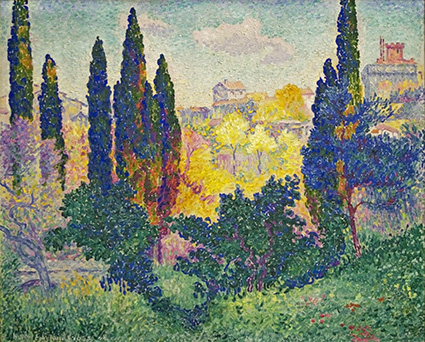
Les cyprès à Cagnes
1908 - 81 x 100 cm - Oil on canvas
Musée d'Orsay, Paris, France >
Théo Van Rysselberghe
* 23. 11. 1862 in Gent; † 13. 12. 1926 in Saint-Clair, France
Self-portrait of van Rysselberghe
Influenced by Manet and Degas, van Rysselberghe, who came from a wealthy family, began painting. He became a founding member of the Belgian group "Société des Vingt" (also known as the "Groupe des XX") in 1883.
Shortly afterwards, during a visit to Paris, he met George Seurat and his pointillist style of painting. This way of painting made a lasting impression on him and he began to paint in this style. It was not until 1910 that he changed his painting style. He was also a very successful designer of posters, furniture and jewellery. In his final years, he moved closer to the Fauve style.
Maria Séthe, de latere Mevrouve Henry Van de Velde
1891 - 118 x 84 cm - Oil on canvas
Koninklijk Museum voor Schone Kunsten, Antwerpen, Belgium >

De lezing door Emile Verhaeren
1903 - 181 x 241 cm - Oil on canvas
Museum for Schone Kunsten (MSK), Gent, Belgium >
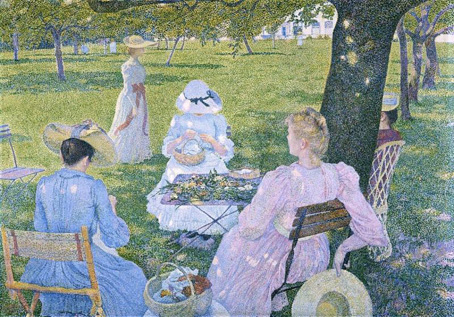
En juli, famille dans le vergers
1890 - 115 x 163 cm - Oil on canvas
Kröller-Müller Museum, Otterlo, Netherlands >
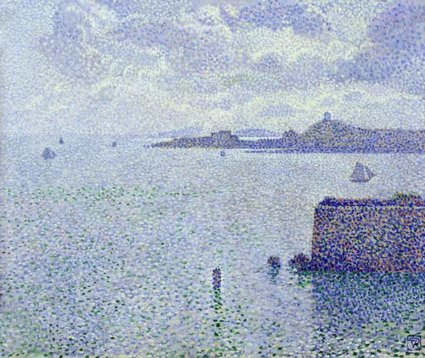
L'entrée du port de Roscoff
1899 - 50 x 61 cm - Oil on canvas
Musée d'Orsay, Paris, France >
Maximilien Jules Luce
* 13. 3. 1858 in Paris; † 6. 2. 1941 Paris
Portrait of Maximilien Luce by Paul Signac
He began his training as an etcher. His close friendship with Camille Pissarro, Seurat and van Rysselberghe led him to become a co-founder of the Pointillist school. For many years, Luce adhered strictly to the theory of this style of painting. He later loosened up his technique.

Matin, intérieur
1890 - 65 x 81 cm - Oil on canvas
Metropolitan Museum of Art, New York, USA >
Le Quai Saint-Michel et Notre Dame
1901 - 73 x 60 cm - Oil on canvas
Musée d'Orsay, Paris, France >
Albert Dubois-Pillet
* 28. 10. 1845 in Paris; † 18. 8. 1890 in Le Puy
Saint-Michel d'Aiguilhe sous la neige
1890 - 61 x 38 cm - Oil on canvas
Musée Crozatier, Puy-en-Velay, France >
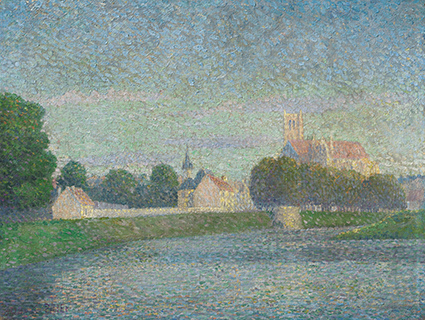
Morgen auf der Marne in Meaux
ca. 1886 - 28 x 37 cm - Oil on canvas
Museum Barberini, Potsdam, Germany >≈≈≈≈≈≈≈
Among the well-known modern artists, there are several who have explored the pointillist style of painting and created their own works in this form.
Henri Matisse
(1869 - 1954)
He is categorised as a Classic Modernist, an important representative of Fauvism. He also experimented with the pointillist style of painting (as already briefly mentioned).
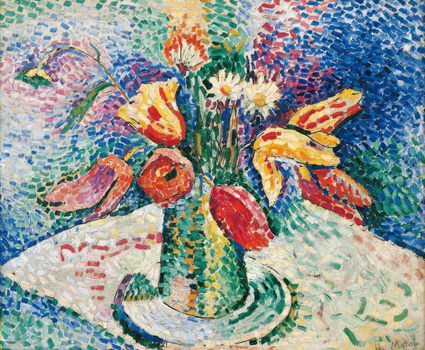
Tulipes de perroquet
1905 - 46 x 55 cm - Oil on canvas
Albertina, Sammlung Batliner, Wien, Austria >

Luxe, calme et volupté
1904 - 98 x 118 cm - Oil on canvas
Centre Pompidou, Paris, France >
≈≈≈≈≈≈≈
The last example may not be correct for everyone, but you can still feel the influence of the pointillist style of painting here. Even if the original approach to content is no longer recognisable here and "only" the technique has been adopted.
Paul Klee
(1879 - 1940)
It is difficult to categorise his work into one style due to its versatility. He is one of the most important artists of classical modernism in the 20th century. Several pointillist paintings date from the time he taught at the Düsseldorf Art Academy. In his own statements, there are very clear links between these paintings and the technique and models of pointillism.
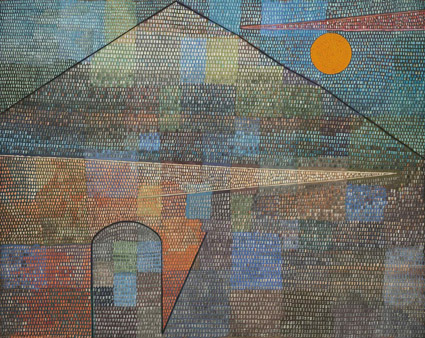
Ad Parnassum
1932 - 100 x 126 cm - Oil on canvas
Kunstmuseum Bern, Suisse

Impressionists
|
PointilismPost-Impressionism |
|
|---|---|---|
Imprint |

